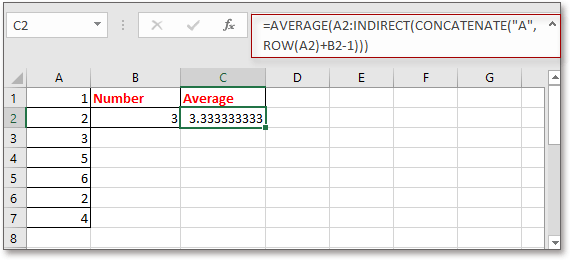Excelで別のセルの値に基づいて範囲を定義するにはどうすればよいですか?
値の範囲を計算することは、ほとんどのExcelユーザーにとって簡単ですが、特定のセル内の数値に基づいて値の範囲を計算したことはありますか?例えば、列Aに値のリストがあり、B2の値に基づいて列Aの値の数を計算したいとします。つまり、B2が4の場合、以下のスクリーンショットのように、列Aの最初の4つの値の平均を求めたいのです。ここで、Excelで別のセルの値に基づいて範囲を迅速に定義するためのシンプルな数式をご紹介します。
 セルの値に基づいて範囲を定義する
セルの値に基づいて範囲を定義する
別のセルの値に基づいて範囲の計算を行うには、シンプルな数式を使用できます。
結果を表示する空白のセルを選択し、この数式を入力します =AVERAGE(A1:INDIRECT(CONCATENATE("A",B2)))、そして Enter キーを押して結果を得ます。
1. この数式では、A1は計算したい列の最初のセル、Aは計算対象の列、B2は基準となるセルです。必要に応じてこれらの参照を変更できます。
2. 合計を行いたい場合は、この数式 =SUM(A1:INDIRECT(CONCATENATE("A",B2))) を使用できます。
3. 定義したい最初のデータがExcelの最初の行にない場合、たとえばセルA2にある場合、次のような数式を使用できます: =AVERAGE(A2:INDIRECT(CONCATENATE("A",ROW(A2)+B2-1))).
Excelで背景色または書式の色に基づいてセルを迅速にカウント/合計する |
場合によっては、複数の色で塗りつぶされたセル範囲があり、同じ色に基づいて値をカウントしたり合計したりしたい場合があります。どのようにすれば迅速に計算できるでしょうか? 使用すると Kutools for Excelの色でカウント機能により、色に基づいてさまざまな計算を迅速に行うことができ、さらに計算結果のレポートを生成することもできます。 Kutoolsをダウンロードして、ぜひお試しください! |
Kutools for Excel - 必要なツールを300以上搭載し、Excelの機能を大幅に強化します。永久に無料で利用できるAI機能もお楽しみください!今すぐ入手 |
最高のオフィス業務効率化ツール
| 🤖 | Kutools AI Aide:データ分析を革新します。主な機能:Intelligent Execution|コード生成|カスタム数式の作成|データの分析とグラフの生成|Kutools Functionsの呼び出し…… |
| 人気の機能:重複の検索・ハイライト・重複をマーキング|空白行を削除|データを失わずに列またはセルを統合|丸める…… | |
| スーパーLOOKUP:複数条件でのVLookup|複数値でのVLookup|複数シートの検索|ファジーマッチ…… | |
| 高度なドロップダウンリスト:ドロップダウンリストを素早く作成|連動ドロップダウンリスト|複数選択ドロップダウンリスト…… | |
| 列マネージャー:指定した数の列を追加 |列の移動 |非表示列の表示/非表示の切替| 範囲&列の比較…… | |
| 注目の機能:グリッドフォーカス|デザインビュー|強化された数式バー|ワークブック&ワークシートの管理|オートテキスト ライブラリ|日付ピッカー|データの統合 |セルの暗号化/復号化|リストで電子メールを送信|スーパーフィルター|特殊フィルタ(太字/斜体/取り消し線などをフィルター)…… | |
| トップ15ツールセット:12 種類のテキストツール(テキストの追加、特定の文字を削除など)|50種類以上のグラフ(ガントチャートなど)|40種類以上の便利な数式(誕生日に基づいて年齢を計算するなど)|19 種類の挿入ツール(QRコードの挿入、パスから画像の挿入など)|12 種類の変換ツール(単語に変換する、通貨変換など)|7種の統合&分割ツール(高度な行のマージ、セルの分割など)|… その他多数 |
Kutools for ExcelでExcelスキルを強化し、これまでにない効率を体感しましょう。 Kutools for Excelは300以上の高度な機能で生産性向上と保存時間を実現します。最も必要な機能はこちらをクリック...
Office TabでOfficeにタブインターフェースを追加し、作業をもっと簡単に
- Word、Excel、PowerPointでタブによる編集・閲覧を実現。
- 新しいウィンドウを開かず、同じウィンドウの新しいタブで複数のドキュメントを開いたり作成できます。
- 生産性が50%向上し、毎日のマウスクリック数を何百回も削減!
全てのKutoolsアドインを一つのインストーラーで
Kutools for Officeスイートは、Excel、Word、Outlook、PowerPoint用アドインとOffice Tab Proをまとめて提供。Officeアプリを横断して働くチームに最適です。
- オールインワンスイート — Excel、Word、Outlook、PowerPoint用アドインとOffice Tab Proが含まれます
- 1つのインストーラー・1つのライセンス —— 数分でセットアップ完了(MSI対応)
- 一括管理でより効率的 —— Officeアプリ間で快適な生産性を発揮
- 30日間フル機能お試し —— 登録やクレジットカード不要
- コストパフォーマンス最適 —— 個別購入よりお得